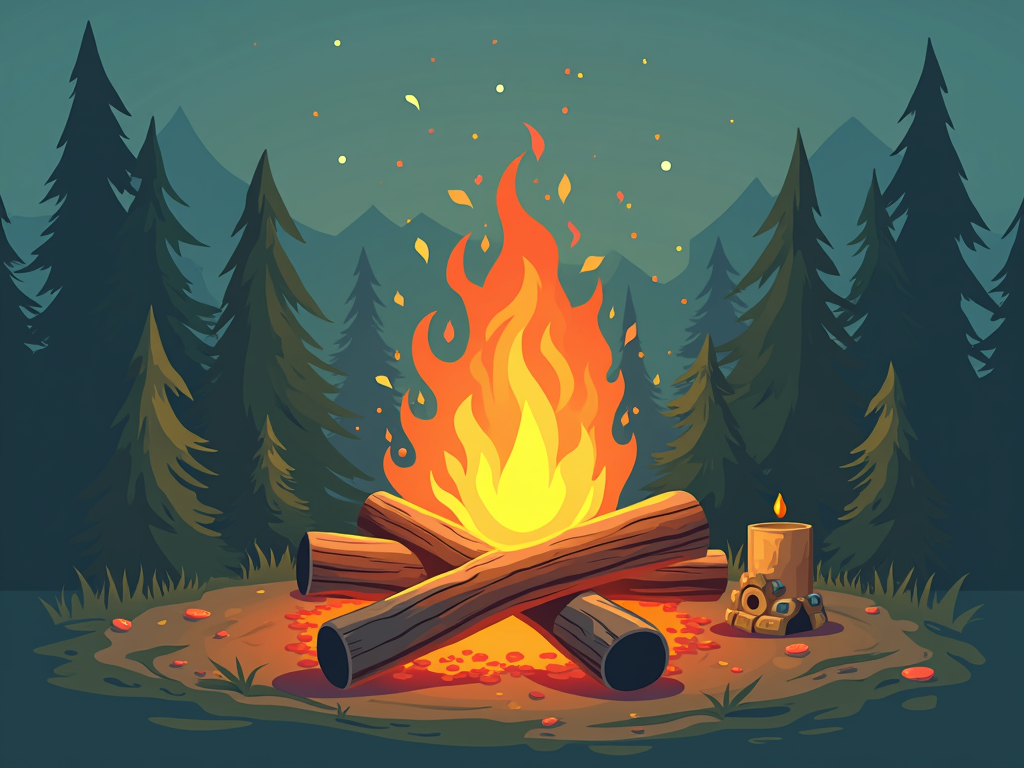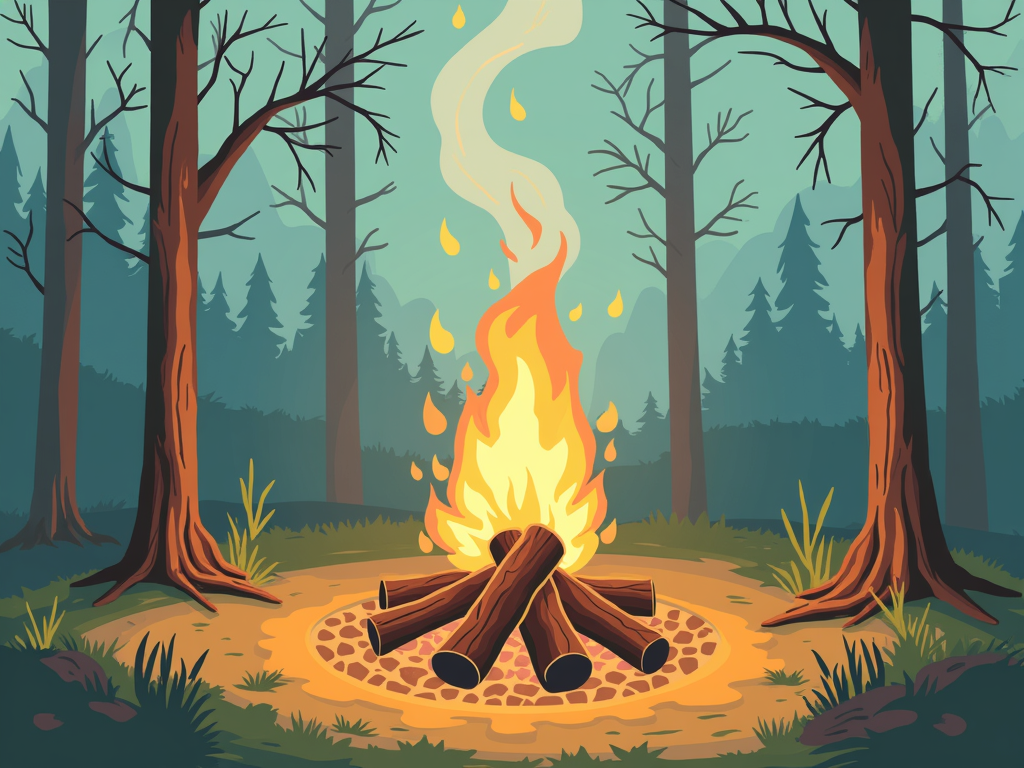Here’s something that’ll blow your mind: your campfire might be three times more polluting than your neighbor’s. Not because they’re some eco-wizard. They just know something you don’t.
The UK Clean Air Strategy dropped a bombshell recently—wood with less than 20% moisture produces 70% fewer particulate emissions than the stuff most people burn. Yeah, seventy percent. That’s not a typo.

While everyone’s obsessing over whether to use oak or pine, they’re missing the real game. It’s not about the species. It’s about the science.
And with places like California already cracking down on wood smoke, this isn’t just tree-hugger talk anymore. Your favorite campsite might start enforcing emission standards sooner than you think.
The good news? Creating a clean-burning campfire is stupidly simple once you know what actually matters.
Understanding Wood Emissions: The Science Behind Clean-Burning Campfires
Let me ruin every campfire wood guide you’ve ever read: they’re all wrong about what matters.
Everyone talks about hardwood versus softwood like it’s some religious debate. Meanwhile, the Forest Service is sitting on data that makes those arguments look ridiculous.
Here’s the deal. Wood moisture content determines about 80% of your emission profile. Not the species. Not whether it’s from a deciduous or coniferous tree. The water content. That’s it.
When wood burns, water doesn’t. Shocking, right? It turns to steam. But here’s where it gets nasty—that steam carries particulates with it. Lots of them.
The UK’s Ecodesign Standards found that wood at 30% moisture creates visible smoke plumes that wood at 15% moisture doesn’t even produce. Think about that next time you’re choking on campfire smoke. You’re literally breathing someone’s poor wood storage habits.

The Boy Scouts of America updated their fire-building guidelines last year to include moisture testing. Not because they suddenly care about the environment. Because kids were getting respiratory issues at jamborees from all the garbage wood people were burning.
Quick Field Tests for Dry Wood
Here’s a field test that works: take a piece of wood and hit it against another piece. Dry wood makes a sharp crack. Wet wood makes a dull thud. Revolutionary technology, I know.
Or look at the ends—dry wood has visible cracks radiating from the center. Wet wood looks smooth and dark.
The National Park Service now recommends the ‘thumbnail test.’ Press your thumbnail into the wood. If it leaves an indent, it’s too wet. Simple as that.
But nobody talks about this stuff because ‘oak burns longer than pine’ makes for a better headline.
Now that you know moisture matters more than species, let’s demolish another myth: that all dry wood burns the same.
The Complete Low-Emission Wood Selection Matrix
Oak at 15% moisture produces three times less smoke than pine at 30% moisture. Let that sink in.
Everything you’ve heard about hardwoods being ‘cleaner’ is based on the assumption that both woods have the same moisture content. They never do.
The Forest Service emission data tells a different story than your camping buddy’s opinions. Properly seasoned pine—we’re talking 18% moisture or less—burns cleaner than poorly stored hickory. The BTU ratings everyone obsesses over? Meaningless if the wood’s creating a smoke signal visible from space.
What Actually Determines Emissions
Here’s what actually determines emissions, in order of importance:
- Moisture content (obviously)
- Resin content
- Wood density
- Cellular structure
Softwoods like pine and fir have more resin, sure. But when properly dried, that resin becomes fuel, not smoke. It’s why Scandinavians have been burning spruce for centuries without turning their saunas into gas chambers.
The real emission villains? Fresh-cut anything, wood stored on the ground, logs with bark still attached, and anything that’s been rained on in the last month.
Your sustainable campfire wood isn’t necessarily local hardwood from that sketchy roadside stand. It’s whatever’s been properly dried and stored.
REI started selling kiln-dried camping wood last year. Overpriced? Absolutely. But it burns so clean you could almost use it indoors. Almost. Don’t actually do that.
The Birch Advantage
Birch deserves special mention. At 20% moisture, it produces some of the lowest particulate counts of any wood. The bark lights easily, burns hot, and leaves minimal ash. Native Americans knew this centuries ago. We’re just catching up with the data to prove it.
Maple and ash come close, but birch is the emissions champion nobody talks about.
Want to really reduce your impact? Mix your wood. Start with super-dry softwood kindling to establish a hot base, then add larger hardwood pieces. The intense initial heat helps the denser wood combust completely. It’s not rocket science, but it might as well be compared to the ‘throw everything on and hope’ method most people use.
Choosing the right wood is only half the battle—how you burn it makes just as much difference.
Advanced Burning Techniques for Minimal Environmental Impact
The Swedish torch method reduces emissions by 40% compared to traditional campfires. Not because the Swedes are environmental geniuses. Because physics doesn’t care about your nationality.
Vertical air flow creates more complete combustion. More complete combustion means less smoke. Less smoke means fewer particulates. It’s beautiful in its simplicity.
Most people build fires like they’re trying to suffocate them. Logs piled on logs, no air gaps, wondering why they’re producing more smoke than heat.
The Science of Structure
The log cabin structure isn’t just for Boy Scout aesthetics. Those gaps between logs create convection currents that feed oxygen to the fire. Oxygen plus heat equals complete combustion. Complete combustion equals minimal emissions. See the pattern?
Here’s something the Leave No Trace principles finally got right: smaller fires burn cleaner. Not just because they use less wood. Because they’re easier to manage. You can maintain optimal air-to-fuel ratios without an engineering degree.
The National Park Service found that fires under 18 inches in diameter produce 60% fewer emissions per BTU than larger fires. But everyone wants their Instagram bonfire.
The Coleman kindling-to-fuel ratio matters more than most people realize. One part kindling to three parts fuel wood. Too little kindling and you get incomplete ignition. Too much and you create unnecessary particulates during the transition. Get it right and you’ll see blue flames at the base—that’s complete combustion in action.
Wind Direction Matters
Here’s a trick from Duraflame’s research team: add wood perpendicular to the prevailing wind, not parallel. It creates turbulence that improves mixing of air and combustible gases. Fancy way of saying it burns cleaner. They figured this out making those processed logs, but it works with regular wood too.
Gradual fuel addition beats the dump-and-pray method every time. Add one piece at a time, wait for full ignition, then add the next. Yeah, it takes patience. But it cuts visible smoke by up to 70%. Your neighbors at the next campsite will thank you. Or at least stop glaring at you.
Now let’s put all this knowledge into a system anyone can follow.
Your Clean Campfire Action Plan
The campfire revolution isn’t coming—it’s here. California’s already enforcing wood smoke regulations. Colorado’s drafting similar rules. Your favorite camping spot might require emission compliance sooner than you think.
But here’s the thing: clean-burning campfires aren’t just better for the environment. They’re better, period. Less smoke in your eyes. More heat from less wood. No angry neighbors.
The science is clear: moisture content trumps wood species, proper structure beats bigger fires, and gradual feeding outperforms the bonfire approach.
Master these principles and you’ll create fires that would make a Forest Service ranger weep with joy.
Start with that thumbnail test on your next wood purchase. Build that Swedish torch instead of your usual pile. Watch those blue flames dance at the base.
You’re not just making a campfire anymore. You’re conducting a controlled combustion experiment that happens to roast marshmallows.
And that’s pretty damn cool.